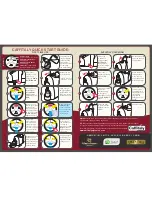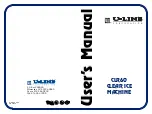
Question 17
Why does my bread rise and then collapse or crater?
The bread may be rising too much. To reduce the rate of rising, reduce the
amount of yeast and/or increase the amount of salt.
Question 18
Can I use my favourite bread recipes (traditional yeast bread) in my
bread machine?
Yes, but you will need to experiment to get the right proportion of ingre-
dients. Become familiar with the unit and make several loaves of bread
before you begin experimenting. Never exceed a total amount of 5 cups dry
ingredients (that includes the total amount of flour, oats, oatmeal, bran).
Use the recipes in this book to help determine the ratio of dry ingredients
to liquid and amounts of yeast, sugar, salt, and oil/butter/margarine to use.
We advise creating your own bread recipes using the basic mode, then pro-
gress to the others, using the Baking cycle times chart as a guide.
Question 19
Is it important for ingredients to be at room temperature before
adding them to the baking pan?
Yes, even when the delay timer is being used. (Water must be between
21°C and 28°C).
Question 20
Why do the loaves vary in height and weight? The whole wheat/
wholewheat breads are always shorter. Am I doing something
wrong?
No, it is normal for wholewheat and wholemeal breads to be shorter and
denser than basic or French breads. Wholewheat and wholemeal flour are
heavier than white bread flour, therefore they don’t rise as much during the
bread baking process. This is also true for bread containing fruit, nuts, oats
and bran.
Question 21
Can I premix the yeast with water?
No, the yeast must be kept dry and put into the baking pan last, above the
flour. This is especially important when the delay timer is being used.
Question 22
Why is there a large hole in the base of the bread?
This hole has been created by the kneading blade. Sometimes this hole is
larger than normal. This is because the dough has rested to the side of the
blade after the second kneading cycle – normal with bread makers. You
could position the dough evenly in the base of the pan..
Question 9
Can I wash the baking pan in the dishwasher?
No. The baking pan and kneading blade must be washed by hand.
Question 10
What will happen if I leave the finished bread in the baking pan?
Whilst still in the breadmaker for the first hour after baking is complete the
bread ‘keeps warm’ to prevent it becoming ‘soggy’. Leaving the bread in the
breadmaker after the keep warm period may result in a ‘soggy’ loaf of bread
as excess steam (moisture) would not be able to escape. Remove and allow
to cool on a wire rack after baking to prevent this.
Question 11
Why did the dough only partially mix? Why didn‘t it mix complete
ly?
The dough may be too heavy or dry. Also, the kneading blade or baking
pan may not be inserted properly. Ingredients may have been added in the
wrong order.
Question 12
Why didn‘t the bread rise?
The yeast could be bad, past it’s sell by date or possibly no yeast was added
at all. Also, if the mixing was not complete, rising problems could develop.
Question 13
What is the minimum and maximum time a cycle may be delayed?
The maximum length of delay is 13 hours including the total cycle time. For
example, Setting 1 (basic small) has a cycle time of 3:20. This start is de-
layed by a maximum of 9:40. The minimum length of delay for each setting
is 10 minutes. The delay clock increases and decreases in increments of 10
minutes.
Question 14
How do I know when to add raisins, nuts, etc. to the bread?
There is a beeper tone to signal that you may add raisins, nuts, etc. during
the second kneading cycle. Note: See ‘Baking cycle times’ chart for ‘Add
nuts & raisins’ time.
In some cases, ingredients can be broken up during the initial kneading cy-
cle. Each recipe indicates the best time to add fruit and nuts to the dough.
Question 15
Why does my bread comes out too moist? What can I do?
Humidity may affect the dough. Add an extra tablespoon of flour. Also, high
altitude may have the same effect. Decrease the amount of yeast by
¼
teaspoon and decrease the sugar and/or water/milk slightly.
Question 16
Why do I get air bubbles at the top of the bread?
This can be caused by using too much yeast. Decrease the yeast by
¼
tsp.
















































